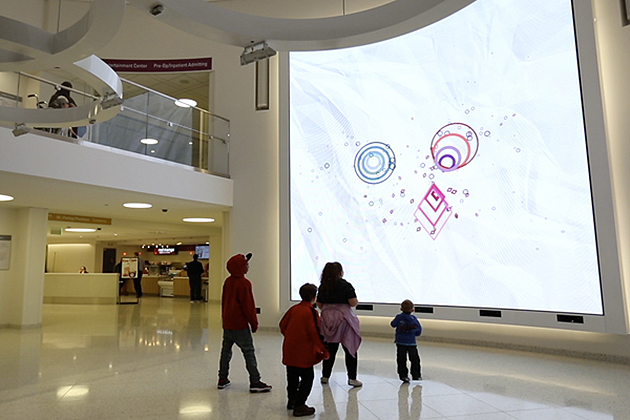For a team of animators used to designing for screens a few inches across, the task of designing a scene three stories high was daunting – especially considering it was created to be viewed by people less than four feet tall.
But that is precisely what the team of UConn faculty and students led by Tim Hunter, professor and chair of digital media design, accomplished with an interactive wall in the newly renovated lobby of the Boston Children’s Hospital.
“The main challenge we had from a design standpoint was the scale. We needed to understand how to make it engaging, and not terrifying,” says Samantha Olschan, assistant professor-in-residence who oversaw the students creating the characters.
Hunter’s team built a series of interactive scenes designed to be friendly and inviting to even the youngest patients. When a child moves into the space, an avatar appears on the screen, and as the child moves around, the avatar tracks their movement, and reacts to gestures like a wave of the hand.
The wall, which towers over the new lobby at a height of nearly 30 feet, comprises a large high-definition video screen, and a series of cameras and sensors that observe the presence and movement of people in the space below it, allowing people entering the space to control what appears on the screen.
That experience can be powerful, says Olschan, and not just for children.
“As we were installing the space, we watched people working on it,” she says. “These were adult men, and they were dancing around, becoming a flower, or a duck. And that’s magical, when you forget about yourself, and let the space transform you.”
Rather than just showing a pretty picture, the wall hopes to offer some therapeutic benefit to the children who interact with it, in support of the mission of the hospital, which is widely considered one of the best pediatric hospitals in the world.
“The idea was to empower emotionally and physically challenged children to take control of something in their life,” says Hunter, “at a time when things were spinning out of control.”
The team was aided in that process by drawing on the expertise of faculty members from a broad range of disciplines across the University. Experts in child psychology, in human behavior, and in several disciplines of computer science and engineering contributed to the development of the installation.
That kind of collaboration was critical to the success of the wall, says Hunter, even though such projects are not usually assigned to an academic institution. “A university is not the first place you would look for something like this,” he says.
By making the project into an active research endeavor, his team was able to focus not just on solving the technical challenges, but on solving them in a way that heightened the user experience and made the technology invisible.
“There’s a ton of technology behind this,” Hunter says, “but at the end of the day, what makes it work is that it feels very human.”



